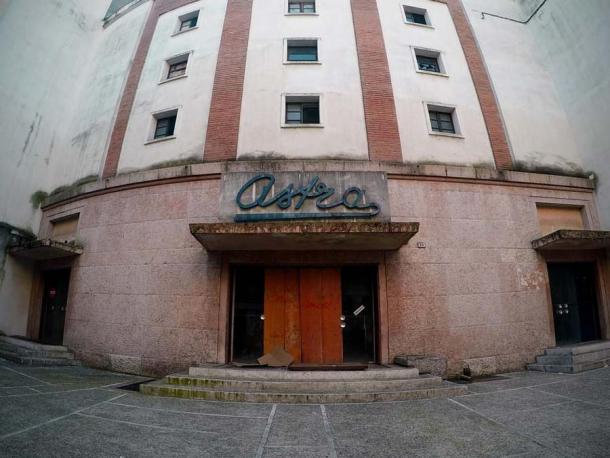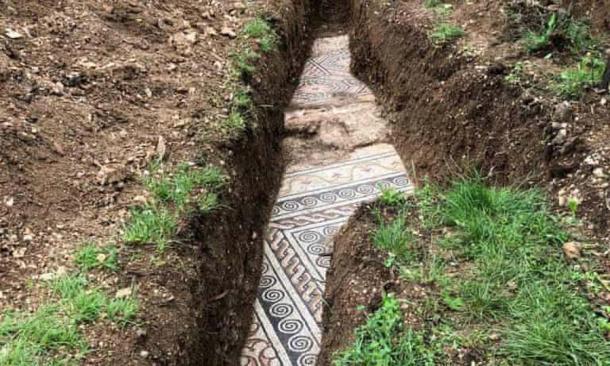
Roman Building Found Under Cinema in Verona A “Miniature Pompeii”
Recently, during excavations carried out in Verona, Italy under an abandoned cinema, archaeologists discovered the remains of a second-century Roman building. According to the Superintendency of Archaeology, Fine Arts and Landscape of Verona, Rovigo and Vicenza, the remains are evocative of a “mini Pompeii,” as quoted in The Smithsonian.
Pompeii itself had lain undiscovered till the 18th century, buried under centuries of volcanic ash, revealing ancient Roman houses in a remarkably well-preserved state. Now this “new” Roman building found beneath the cinema is drawing comparisons to the demise of Pompeii by volcanic fire and the city’s legendary fresco paintings.
When Mount Vesuvius had its fateful eruption in 79 AD, it was one of the deadliest ever in European history. To put into context, it released 100,000 times the thermal energy of the atomic bombings of Hiroshima and Nagasaki! A consequence was the untimely demise of several Roman towns and cities in their entirety, including Herculaneum and Pompeii, the latter under 20 feet (6.3 meters) of volcanic ash. Pompei lives on in popular culture because of how it was destroyed and for the exceptional art and architecture that miraculously survived the tragic explosion of Mount Vesuvius.

The Cinema Teatro Astra closed nearly 20 years ago. But it was beneath its floor that the ancient Roman building, now called a "miniature Pompeii" was found. (Bruno / CC BY-SA 2.0)
The Roman Building Under the Cinema Teatro Astra of Verona
The Cinema Teatro Astra was a center of arts, theatre, film, the opera and other performance forms in its heyday in Verona. It is now undergoing renovation after having been abandoned for more than two decades. Back in 2005, the first signs of the “frescoed walls reminiscent of Pompeii” turned up during construction.
- Romeo and Juliet: Not a Shakespearean Tale After All
- Stunning Pompeii Hunting Fresco Restored With Laser
The chief superintendent, along with the archaeology team, deduced that this ancient Roman building was probably abandoned after a great fire but “the environment was preserved intact, with the magnificent colors of the frescoed walls dating back to the second century.”
The building probably survived the ancient fire as a result of the roof collapsing almost immediately. The ruins include charred wooden furniture and the remains of the collapsed ceiling. They also discovered a heating system “tiled with decorative tesserae,” which was found in both the walls and the floor, as per Artnet News.
While the function of this very old Roman building remains unknown, parallels have been drawn with ancient Pompeii’s untimely demise. The abandoned cinema is located near the center of the northern Italian city of Verona, which is famous as the setting for Shakespeare’s Romeo and Juliet.

Fresco paintings are famous throughout the world and no country has more great frescoes than Italy. The most famous fresco of all is probably this one: The Creation of Adam by Michelangelo. (Adrian / Adobe Stock)
Ancient Pompeii and the Fresco Technique
Fresco is an Italian adjective meaning fresh. It is also a technique of mural painting wherein freshly laid lime plaster is worked upon, using water as “the vehicle for the dry-powder pigment” to merge with the plaster. While frescoes have been painted since antiquity, it was particularly popular again during the Italian Renaissance. For example, The Creation of Adam, one of Michelangelo’s finest works, is a fresco style painting.
Pompeii, which was discovered in such pristine condition owing to the strange way the volcanic ash protected it, is one of the finest locations in all of Italy for ancient mural and fresco painting. The famous Villa dei Misteri, from the 1st century BC at Pompeii in southern Italy, is one such example. In this villa, or house, the fresco paintings inside reportedly show the initiation of a young woman into a Greco-Roman mystery cult.
Pompeii frescoes used a technique of thin-layering limestone plaster, known as intonaco, spread over a wall surface that was still damp and then painted over. This is the reason why these paintings survive time and the secret of their long-lasting vibrant colors, even a thousand years after they were painted.
The paint pigments mixed with the intonaco, and upon drying, “sealed” the entire surface. This preservation and the unique style of frescoed walls found under the Verona cinema, was one of the key reasons why the chief superintendent drew a parallel with Pompeii.

This ancient Roman mosaic was also found in Verona a few meters beneath a row of vines in the week when work resumed after the coronavirus lockdown. (Comune di Negrar di Valpolicella)
Other Recent Discoveries in Verona and Pompeii
Just last year, a perfectly preserved ancient Roman mosaic floor was discovered on the outskirts of Verona, reports The Guardian. The multicolored tiles were linked to the foundation of a Roman villa discovered in 1922, in a hilly area above the town of Negrar di Valpolicella. This villa was dated to the 3rd century, hidden by nature under a thick network of vines.
- Pristine Roman Mosaic Floor Found Under Vineyard In Italy
- Like Something Out of The Walking Dead: Medieval Warrior Found with Knife Hand Prosthesis
And a few months ago, archaeologists unearthed a unique well-preserved ancient Roman ceremonial carriage from a villa outside Pompeii. The four wheeled carriage was made of bronze, tin and iron. Italy's culture ministry described the carriage as "a unique find, without any precedent in Italy," in The Independent.
Going forward, the agency plans to use special photo software to recreate 3-D textured models of the sections and reliefs of the Roman building and its frescos, found under the Verona cinema. Some of the tiles found in the ruins were made of tesserae (small pieces of glass, stone and ceramic used in mosaic work) and crustae (blocks of colored marble). These matched with the finds at Pompeii. Local officials are hoping to open the historical site to the public as soon as they can.
Top image: Researchers found the charred remains of wooden furniture at the site of the former Astra cinema in Verona leading them to the discovery of the ancient Roman building that is now being called a "miniature Pompeii." Source: Superintendency of Archaeology, Fine Arts and Landscape of Verona, Rovigo and Vicenza
By Rudra Bhushan
References
Cascone, S. 2021. ‘A unique find without any precedent’. Construction workers discover a ‘miniature Pompeii’ buried in Verona. Available at: https://news.artnet.com/art-world/minature-pompeii-discovered-in-verona-1980538.
Gershon, L. 2021. “Miniature Pompeii” found beneath abandoned Verona Cinema. Available at: https://www.smithsonianmag.com/smart-news/mini-pompeii-found-under-verona-cinema-180978006/.
Giuffrida, A. 2021. “Miniature Pompeii” found beneath former cinema in Verona. Available at: https://www.theguardian.com/world/2021/jun/15/miniature-pompeii-found-beneath-former-cinema-verona.
















Comments
Couple things to note: 1) No dark-haired people in the mural, suggesting NO Roman influence. Compare it these Roman-era frescas:
https://www.historyhit.com/app/uploads/2021/07/Dressing-of-a-priestess-o...
https://upload.wikimedia.org/wikipedia/commons/c/c3/Zetoyanfion.jpg
And 2) there’s no way a volcanic eruption buried this ceramic floor like this (https://www.ancient-origins.net/sites/default/files/styles/large/public/...). That’s NOT volcanic soil, that's the result of either a mudslide, or (more likely) it’s pre-Ice Age – i.e., the accumulation of tens of thousands of years of an annual organic fall.
Nobody gets paid to tell the truth.